Superior Mesenteric Artery Syndrome- A Rare Case Report
advertisement
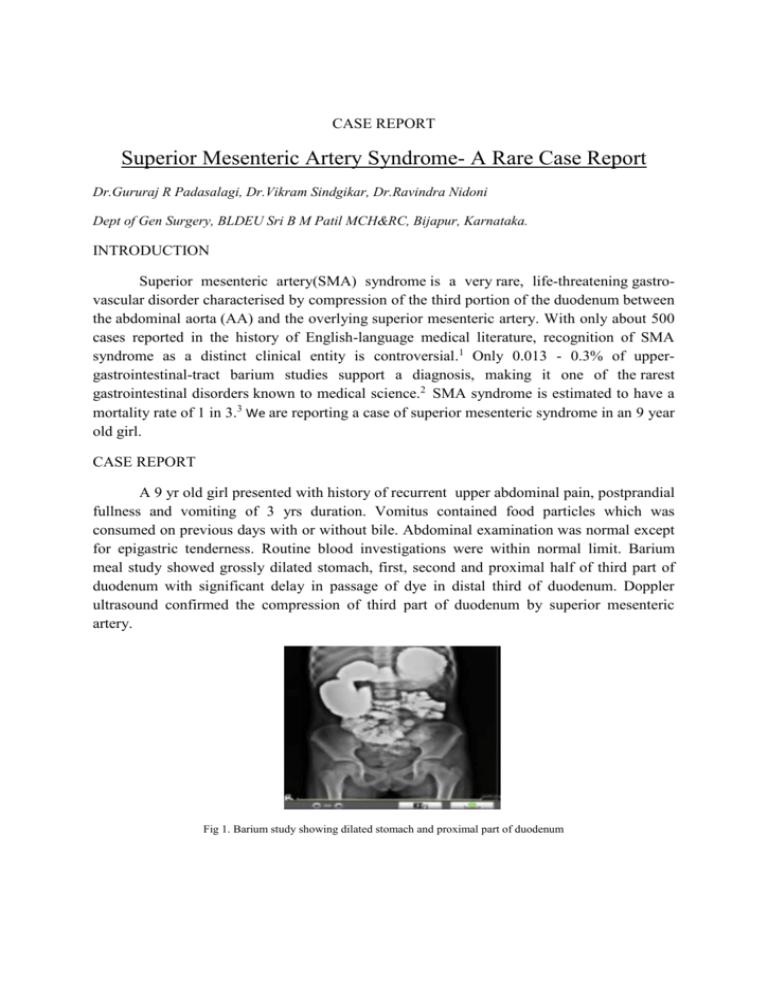
CASE REPORT Superior Mesenteric Artery Syndrome- A Rare Case Report Dr.Gururaj R Padasalagi, Dr.Vikram Sindgikar, Dr.Ravindra Nidoni Dept of Gen Surgery, BLDEU Sri B M Patil MCH&RC, Bijapur, Karnataka. INTRODUCTION Superior mesenteric artery(SMA) syndrome is a very rare, life-threatening gastrovascular disorder characterised by compression of the third portion of the duodenum between the abdominal aorta (AA) and the overlying superior mesenteric artery. With only about 500 cases reported in the history of English-language medical literature, recognition of SMA syndrome as a distinct clinical entity is controversial.1 Only 0.013 - 0.3% of uppergastrointestinal-tract barium studies support a diagnosis, making it one of the rarest gastrointestinal disorders known to medical science.2 SMA syndrome is estimated to have a mortality rate of 1 in 3.3 We are reporting a case of superior mesenteric syndrome in an 9 year old girl. CASE REPORT A 9 yr old girl presented with history of recurrent upper abdominal pain, postprandial fullness and vomiting of 3 yrs duration. Vomitus contained food particles which was consumed on previous days with or without bile. Abdominal examination was normal except for epigastric tenderness. Routine blood investigations were within normal limit. Barium meal study showed grossly dilated stomach, first, second and proximal half of third part of duodenum with significant delay in passage of dye in distal third of duodenum. Doppler ultrasound confirmed the compression of third part of duodenum by superior mesenteric artery. Fig 1. Barium study showing dilated stomach and proximal part of duodenum Patient underwent laparotomy and division of ligament of treitz with duodenojejunotomy. Peri and Post operative period was uneventful. Patient was started on liquid diet on third post operative day and switched to normal diet on fifth post operative day. Fig 2. Intraop mobilization of duodenum Fig 3. Duodeno-jejunostomy Barium meal follow through on 12th post operative day showed smooth flow of dye. Follow up on first and third month post surgery was uneventful. Fig 4. Postop barium study showing smooth distal flow of dye DISCUSSION SMA syndrome was first described in 1861 by Carl Freiherr von Rokitansky in victims at autopsy, but remained pathologically undefined until 1927 when Wilkie published the first comprehensive series of 75 patients.4 The syndrome is typically caused by an angle of 6°-25° between the AA and the SMA, in comparison to the normal range of 38°-56°, due to a lack of retroperitoneal and visceral fat. In addition, the aortomesenteric distance is 2-8 millimeters, as opposed to the typical 10-20.2 Females are impacted twice as often as males, with 75% of cases occurring between the ages of 10 and 30. Retroperitoneal fat and lymphatic tissue normally serve as a cushion for the duodenum, protecting it from compression by the SMA. Acute loss of the retroperitoneal fat pad between the SMA and the aorta due to significant weight loss seen in patients with severe wasting conditions such as burns, severe trauma, cancers, eating disorders, or drug abuse results in narrowing of the aortomesenteric angle. Conditions that lead to prolonged bed rest including severe head trauma, cerebral palsy, paraplegia and application of a body cast may press the SMA against the duodenum or compress the duodenum against the hyperextended lumbar spine. Rapid growth spurts that exceed compensatory weight gain in adolescents, iatrogenic postoperative obstruction, adhesions, and an enlarged abdominal aortic aneurysm may also lead to vascular compression of the duodenum.5 Symptoms include early satiety, nausea, vomiting, extreme "stabbing" postprandial abdominal pain , abdominal distention/distortion, eructation, external hypersensitivity or tenderness of the abdominal area, and severe malnutrition accompanying spontaneous wasting.6 "Food fear" is a common development among patients with the chronic form of SMA syndrome. Symptoms are partially relieved when in the left lateral decubitus or knee-to-chest position. Diagnosis is very difficult, and confirmation of the diagnosis requires a high degree of clinical suspicion and a meticulous radiographic evaluation during an acute attack. Plain radiographs of the abdomen may demonstrate dilation of the stomach and duodenum with little gas and no air fluid levels in the distal bowel. An upper gastrointestinal (UGI) tract series reveals dilation of the stomach and the first and second portion of the duodenum, retention of barium within the duodenum, and a characteristic vertical or linear cutoff extrinsic defect in the third portion of the duodenum. The use of hypotonic duodenography can increase diagnostic accuracy to 90%. Aortic and SMA angiography in conjunction with hypotonic duodenography can delineate the aortomesenteric angle and crossing of the SMA over the duodenum at the site of obstruction and is considered the gold standard. Computed tomography scan with oral and IV contrast can potentially diagnose the condition and also the other causes of duodenal obstruction. 5 SMA syndrome can present in acute, acquired form as well as chronic. Acute cases usually respond to medical management, while chronic cases require surgical intervention. In acute or mild cases, conservative treatment should be attempted first. If conservative treatment fails, or if the case is severe or chronic, surgical intervention is required. Duodenojejunostomy with division of the ligament of Treitz is the procedure of choice. The procedure can be performed as either an open surgery or laparoscopically.5 CONCLUSION Superior mesenteric artery syndrome is a very rare cause of duodenal obstruction and requires high index of suspicion. We are reporting a case of Superior mesenteric artery syndrome managed successfully with no morbidity. REFERENCES 1. Cohen LB, Field SP, Sachar DB (1985). "The superior mesenteric artery syndrome. The disease that isn't, or is it?".J. Clin. Gastroenterol. 7 (2): 113–6. 2. Avinash Shetty(2006-07-16). "Superior eMedicine. WebMD. Retrieved 2008-04-09. Mesenteric Artery Syndrome". 3. Christopher T. Buresh, MD, and Mark A. Graber, MD. "Unusual Causes of Recurrent Abdominal Pain", Emerg Med 38(5):11-18, 2006. 4. Welsch T, Büchler MW, Kienle P (2007). "Recalling superior mesenteric artery syndrome". Dig Surg 24 (3): 149–56. . 5. Josef E.Fischer, Kirby I.Bland. “Vascular compression of duodenum,” Mastery of surgery, 5th Ed. Vol 1, 957. 6. Baltazar U, Dunn J, Floresguerra C, Schmidt L, Browder W (2000). "Superior mesenteric artery syndrome: an uncommon cause of intestinal obstruction". South. Med. J. 93 (6): 606–8.
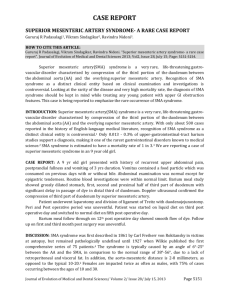
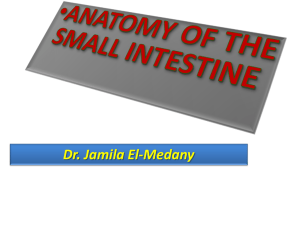
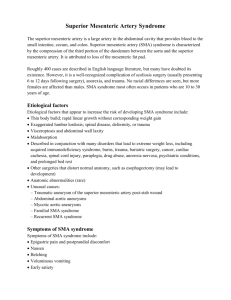
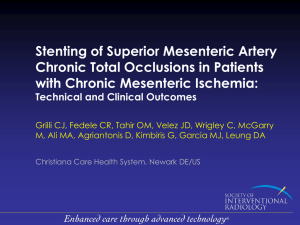
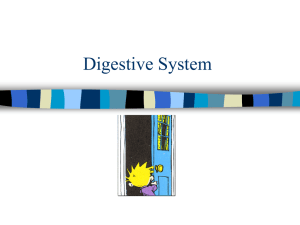




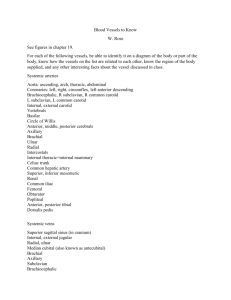
![Paper_Prof_Wang_final1[1]](http://s3.studylib.net/store/data/005836194_1-85fb8d8882c087decd1a6d9c9fdc99c0-300x300.png)